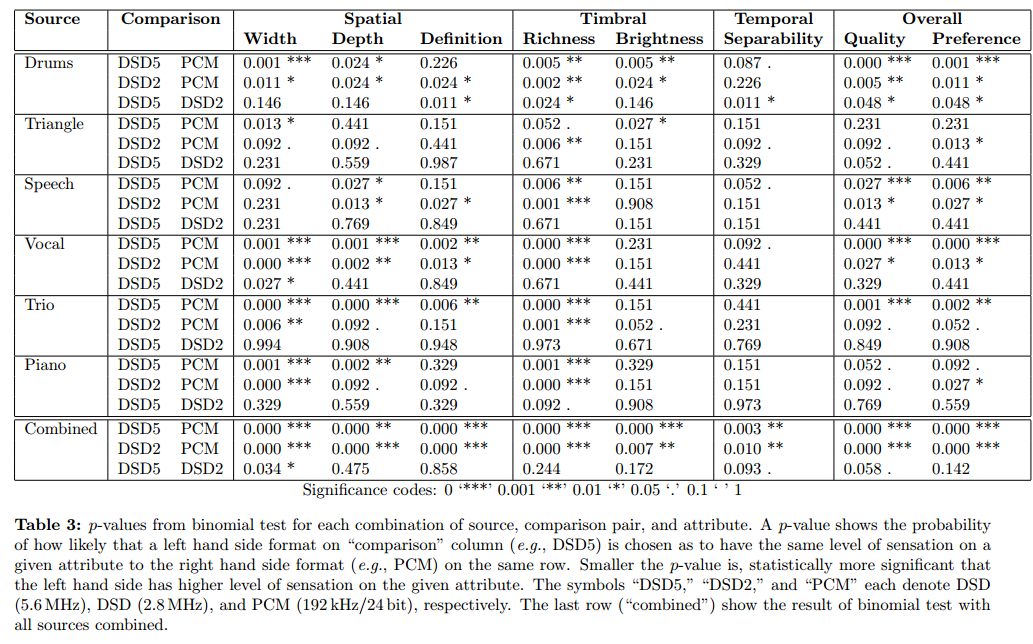AES E-Library » Subjective Evaluation of High Resolution Recordings in PCM and DSD Audio Formats
Subjective Evaluation of High Resolution Recordings in PCM and DSD Audio Formats
Atsushi MARUI1 , Toru KAMEKAWA1 , Kazuhiko ENDO2 , and Erisa SATO Faculty of Music, Tokyo University of the Arts, 1-25-1 Senju, Adachi, Tokyo, 120-0034, Japan TEAC Corporation, 1-47 Ochiai, Tama, Tokyo, 206-8530, Japan Correspondence should be addressed to Atsushi MARUI (marui@ms.geidai.ac.jp)
Presented at the 136th Convention 2014 April 26–29 Berlin, Germany
Lo studio è un confronto AB accoppiato. Hanno messo PCM 192 a confronto con DSD64 e DSD128, e DSD64 a confronto con DSD128. Ciò che lo rende strano è che i risultati grezzi non vengono riportati, solo il fattore "p" o probabilità di possibilità. Il test è di preferenza, non è se gli ascoltatori possano differenziare i brani.
Il test utilizza altoparlanti e due players TASCAM con clock sincronizzati:
"Two TASCAM DA-3000 (from the same production lot with the same firmware version installed) were used for playback of all the stimuli. They were set to master- and slave-mode for playback synchronization. Hence, the same digital-to-analog converter was used for all stimuli played back. Outputs from DA-3000 were sent to a remote controllable monitor switcher (operates in analog domain) which enabled a listener to switch between one of the two playback sources.
Two loudspeakers were positioned in the standard stereo playback according to ITU-R BS.775 [6], with 2.70 m (≈ 8.86 feet) from the listening position (Figure 2). Two Genelec 1032A were used at Site A and Genelec 8050A were used at Site B. A stereo volume controller was installed as a precaution for loud noise exposure to human subjects. Because no loud noise was emitted by accident, the level was kept at constant level throughout the experiment. Esoteric C-02 preamplifier was used at Site A and Tomoca TCC-100ST was used at Site B for the volume controller."
Le stanze ITU dovrebbero rappresentare il tipico salotto. In realtà non lo sono, ma è una configurazione standard che rende più facile confrontare uno studio ad un altro effettuato in una stanza simile.
Questi sono i risultati del test:
Non lo riuscite a capire? E' normale. Non credo che la maggior parte delle persone ci riesca. Essenzialmente dice che più piccolo è il valore, più alto è il numero di ascoltatori che preferivano il formato sulla sinistra a quella di destra nella specifica categoria di effetto ("Source"). E' anche vero che è la prima volta che vedo questo metodo per una tabella di confronto.
Ecco la loro conclusione:
"The three formats were compared by 46 participants on six sound programs and eight attributes. From the result of binomial test applied on the data from pairwise comparison experiment, statistically significant differences between PCM and DSD but not between the two sampling frequencies (2.8 MHz and 5.6 MHz) of DSD.
[...] formats, stimuli having broad spectra and clear temporal transients (such as Vocal, Jazz Trio, and Piano) and attributes such as spatial width, spatial depth, timbral richness were able to be used to discriminate between DSD and PCM. Overall quality and preference showed similar tendency of in favor of DSD (5.6 MHz) over PCM (192 kHz/24 bit)."
Ringrazio Amir Majidimehr per la segnalazione.







 Rispondi quotando
Rispondi quotando